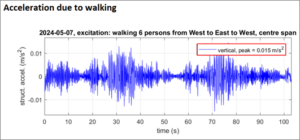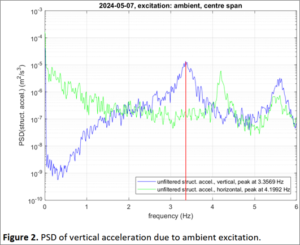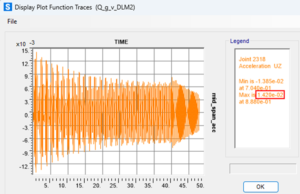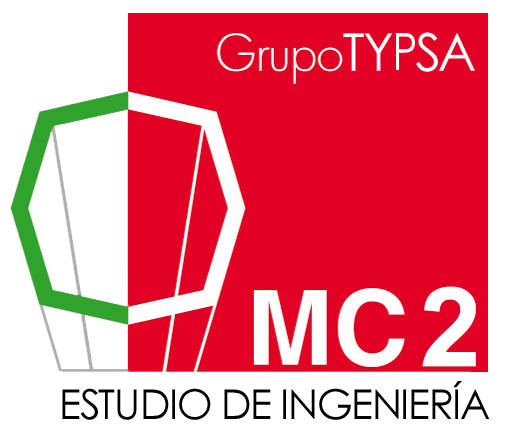A dynamic test of the Les Cèdres footbridge has recently been carried out with the double goal of corroborating that the real structure behaves according to the analytical predictions and, on the other hand, certifying that the CL 1 class of maximum comfort for users is respected, without the need to install a tuned mass damper (TMD) into the deck.
To do this, an accelerometer is placed at mid-span and on the axis of the deck, thus at the antinode of the first vertical flexural mode of the structure. These are the main characteristics of the system:
- Vertical and horizontal sensitivity: 4.7363 and 4.5125 V/(m/s2) respectively
- Acquisition frequency: 100 Hz
A synthesis of the obtained results is presented as follows:
- Frequency of the first vibration mode of the structure:
- Frequency f1 calculated through a model with articulated supports: 3.144 Hz
- Frequency f1 calculated through a model with built-in supports: 3.211 Hz
- Dynamic test result (ambient excitation): 3.357 Hz
- The correspondence between the modelled structure and the real one is evident (ftest / f model = 1.07÷1.04), the latter being slightly stiffer, as it usually takes place.
- Vertical acceleration of the footbridge subjected to the action of 6 people walking, more or less synchronized, with an excitation frequency between 2.2 and 2.5 Hz. The dynamic test provides an acceleration of 0.015 m/s2. In the calculation model, the structure is excited by the load model DLM 2 defined in bulletin 32 of the fib, describing the effect of a group with a limited number of unsorted walking persons (8-15 persons). With an excitation frequency of 2.2 Hz and 2.5 Hz, vertical accelerations in the centre of the span are 0.009 and 0.0142 m/s2 respectively.
- Other tests are carried out, obtaining the following values of maximum vertical acceleration:
- Group of 10 people walking, more or less synchronized, with an excitation frequency of between 2.2 and 2.5 Hz: a= 0.029 m/s2.
- Group of 6 people running, more or less synchronized, with an excitation frequency of around 3 Hz: a= 0.169 m/s2.
Conclusions:
- The correspondence between the calculation model and the real structure is confirmed.
- The frequency of the first mode of vibration, around 3.4 Hz, is very far from the ranges that Codes consider as critical for the structure to suffer from resonance under dynamic excitation produced by people walking:
- EN-ISO 10137: 1.2-2.4 Hz
- Eurocode 2: 1.6-2.4 Hz
- Sétra technical guide. Footbridges: assessment of vibrational behaviour under pedestrian loading: 1.7-2.1 Hz (maximum risk); 1.0-1.7 and 2.1-2.6 (medium risk); 2.6-5.0 (low risk).
- The frequency is high even when compared to the typical frequencies of the dynamic action corresponding to people running: 2.8-3.2 Hz.
- The vertical acceleration values are very far from the limit of 0.5 m/s2 that allows the footbridge to show a maximum comfort class.
- It is not necessary to install a tunes mass damper (TMD) inside the steel box of the deck, at mid-span.
Luca Ceriani from MC2, responsible of all the design process, and the MFIC Ingénieurs Civils team, based in Morges (Lausanne, Switzerland) and local partner of MC2, participated in the tests, carried out by Maurer.






